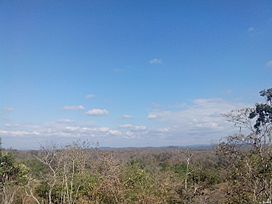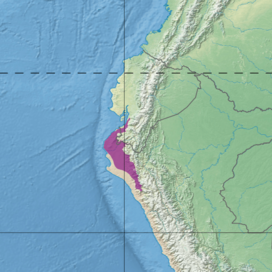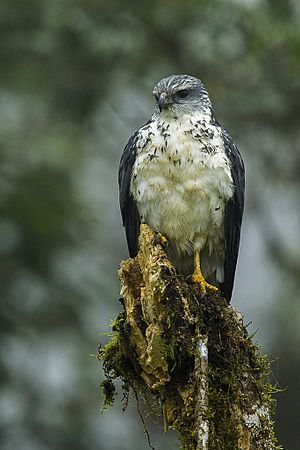Tumbes–Piura dry forests facts for kids
Quick facts for kids Tumbes–Piura dry forests (NT0232) |
|
|---|---|

Tumbes Region dry forest
|
|

Ecoregion territory (in purple)
|
|
| Ecology | |
| Realm | Neotropical |
| Biome | Tropical and subtropical dry broadleaf forests |
| Borders |
List
|
| Geography | |
| Area | 41,180 km2 (15,900 sq mi) |
| Countries | Ecuador, Peru |
| Coordinates | 5°44′10″S 80°21′40″W / 5.736°S 80.361°W |
| Climate type | BWh: arid; desert; hot arid |
| Conservation | |
| Conservation status | Critical/endangered |
| Global 200 | Tumbesian-Andean Valleys Dry Forests |
The Tumbes–Piura dry forests (NT0232) is a special dry forest area. It stretches along the Pacific coast in southern Ecuador and northern Peru. This ecoregion is home to many unique plants and birds. They have learned to live with a short rainy season and a long dry season. Sadly, this area faces threats. People cut down trees for wood and catch wild birds to sell them.
Contents
Where are the Tumbes–Piura Dry Forests?
This dry forest area covers about 4,118,081 hectares (10,176,000 acres). That's a huge space! The northern part is in Ecuador, and most of it is in Peru. In Peru, it includes parts of the Tumbes, Piura, Lambayeque, and Cajamarca areas.
To the north, you'll find similar dry forests in Ecuador. The tall Andes mountains are to the east. This ecoregion touches many other natural areas:
- To the north, it meets the Guayaquil flooded grasslands.
- It also borders South American Pacific mangroves and Northwestern Andean montane forests.
- Further south, it reaches the Pacific Ocean.
- It also borders the Eastern Cordillera Real montane forests.
- Even further south, it's next to the Sechura Desert.
- It also touches parts of the Marañón dry forests, Peruvian Yungas, and Cordillera Central páramo.
What is the Land Like?
The land here has different features. You can find flat coastal areas, gentle rolling hills, and the lower parts of the Andes mountains.
Soils and Rivers
The soils near the coast are mostly sand and clay. These formed recently. Higher up, the soils are made from older rocks like granite and slate.
Several important rivers flow through this region all year. They usually start in Ecuador. These include the Guayas, Zarumilla, Tumbes, Piura, and Chira rivers. Other smaller streams only flow when it rains.
What is the Climate Like?
The climate in the Tumbes–Piura dry forests is very dry. It's a hot desert climate.
Temperature and Rainfall
The average temperature is usually between 24 °C (75 °F) and 27 °C (81 °F). For example, in one spot, the average temperature is about 24 °C (75 °F). The hottest it gets is around 30 °C (86 °F), and the coolest is about 18 °C (64 °F). Temperatures change a bit throughout the year, from 21.6 °C (70.9 °F) in July–August to 26.9 °C (80.4 °F) in February–March.
There is a rainy season from January to March. The rest of the year is very dry. This area usually gets 100 millimetres (3.9 in) to 500 millimetres (20 in) of rain each year.
El Niño's Impact
The El Niño–Southern Oscillation is a big event here. When El Niño happens, there's a lot more rain. This causes thousands of plants to grow, which provides food for many animals.
The Amazing Ecosystem
The Tumbes–Piura dry forests are part of the Neotropical region. They are a type of tropical and subtropical dry broadleaf forests. This area is also part of the Tumbes–Chocó–Magdalena biodiversity hotspot. A hotspot is a place with many different kinds of plants and animals that are also in danger.
This ecoregion is part of a larger area called the Tumbesian-Andean Valleys Dry Forests. This bigger area covers 103,000 square kilometres (40,000 sq mi) and includes six other dry forest regions. Many plants and animals found here are endemic, meaning they live nowhere else in the world!
Unique Plants (Flora)
This dry forest has many different types of habitats. You can find desert areas with shrubs and cacti. There are also thick thorn forests. Many plants here are unique and have adapted to the dry conditions.
Large parts of the forest are made of trees that lose their leaves after the rainy season. Some common trees in these dry forests include Loxopterygium huasango, Handroanthus billbergii, and holy wood (Bursera graveolens). Sadly, people often cut these trees down.
Other common plants are Ziziphus thyrsiflora, Caesalpinea corymbosa, Capparis angulata, Bombax discolor, Pitthecellobium multiflorum, and Geoffroya striata.
- The ceibal forest is mostly made up of the unique Ceiba trischistandra tree.
- The chaparral has many shrubs like papelillo (a type of Bouganvillea), cacti, and overo (Cordia lutea).
- The area is also rich in mesquite (Prosopis genus) trees. These trees help the soil by adding nitrogen, which helps other plants grow.
- The algarrobal is mainly made of algarrobo trees, which are also a type of mesquite.
Amazing Animals (Fauna)
The Tumbes–Piura dry forests are home to many different animals.

Mammals, Reptiles, and Amphibians
You can find six types of mammals, two types of reptiles, and one type of amphibian here. Some common animals include the southern tamandua (Tamandua tetradactyla), Guayaquil squirrel (Sciurus stramineus), and green iguana (Iguana iguana).
Some reptiles are endangered, like the green sea turtle (Chelonia mydas) and the hawksbill sea turtle (Eretmochelys imbricata). The false monitor tegu (Callopistes flavipunctatus) is also close to being threatened. The phantasmal poison frog (Epipedobates tricolor) is an endangered amphibian.
Birds
There are 14 different types of birds, and many of them are found only here! Some bird species include the El Oro parakeet (Pyrrhura orcesi) and the white-edged oriole (Icterus graceannae).
Many birds here are endangered:
- grey-cheeked parakeet (Brotogeris pyrrhoptera)
- grey-backed hawk (Pseudastur occidentalis)
- rufous flycatcher (Myiarchus semirufus)
- slaty becard (Pachyramphus spodiurus)
- white-winged guan (Penelope albipennis)
- Peruvian plantcutter (Phytotoma raimondii)
- El Oro parakeet (Pyrrhura orcesi)
- yellow-bellied seedeater (Sporophila nigricollis)
- Peruvian tern (Sternula lorata)
- blackish-headed spinetail (Synallaxis tithys)
The bronze-winged parrot (Pionus chalcopterus) and saffron siskin (Spinus siemiradzkii) are also in danger. Birds that are found in only a few places include the white-tailed jay (Cyanocorax mystacalis) and the red-masked parakeet (Psittacara erythrogenys).
What is the Conservation Status?
The World Wildlife Foundation says this ecoregion is "Critical/Endangered." This means it's in serious trouble and needs help.
Past and Present Threats
In the past, people took too many animals and plants from this area. They caught parrots and parakeets to sell as pets. They also hunted some mammals and reptiles for food. Trees were cut down for firewood, charcoal, and timber.
Hope for the Future
By the year 2000, some good changes started to happen. This was partly because of the effects of El Niño and partly because of the creation of the Cerros de Amotape National Park. The park managers and other groups are working with local communities. They are trying to find ways to protect the amazing plants and animals that live here. The Reserva del Noroeste biosphere reserve also helps protect this special place.
Sources
See also
 In Spanish: Bosque seco de Tumbes-Piura para niños
In Spanish: Bosque seco de Tumbes-Piura para niños

